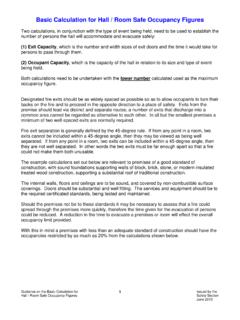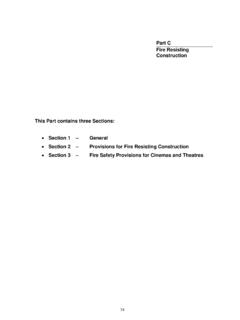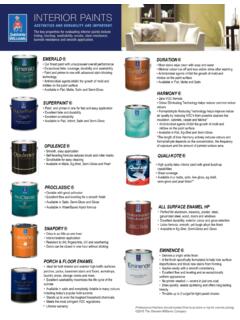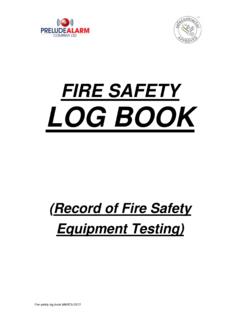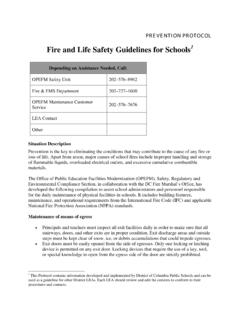Transcription of Fire Doors Basic Guidance & Checklist - London Borough of ...
1 fire Safety Guidance Note 7 Issued by the Safety Section June 2013 1 fire Doors Basic Guidance & Checklist Introduction fire Doors and all passive fire protection products play a unique role in fire safety by containing a fire to a single compartment of a building and therefore reducing the risk to those in other compartments. Properly maintained fire Doors should be part of the fire safety plan for every building.
2 When a fire door is installed, it should be done so with certificated components that will ensure it achieves its fire rating. Over time, without the correct maintenance, the fire door could fail so it is a statutory requirement that Doors located on protected fire routes, Doors to restrict the passage of smoke and final fire exit Doors should all be regularly inspected to ensure that they function correctly and to the standard originally intended when the Doors were installed. The frequency of each inspection should be determined by assessing among other things the amount of use the door is subjected to, the criticality of the area and who it protects. This may result in a requirement for the Doors to be inspected weekly or monthly but all fire Doors must be inspected at least once a year.
3 Door leaf & frame All fire Doors should close effectively from any angle of opening using only the door closer and fit snugly in their frames. There must be free movement Doors should freely swing through their normal arc without slowing or grounding on the floor. There are a number of reasons why Doors may fail to close: Check that there are no foreign bodies or other objects obstructing the door. Check for scuffmarks on the floor that could indicate the door is not moving freely. Check that any smoke seals are correctly fitted and are undamaged. Check the latch, if fitted to ensure correct operation and that it is suitably lubricated. Only as a last resort should the closing device be adjusted, but this must be carried out carefully to ensure that the Doors can be opened without undue force.
4 Ensure all obstructions are removed and the circumstances associated with it reported to the appropriate line manager fire Safety Guidance Note 7 Issued by the Safety Section June 2013 2 The door and frame must remain square and should not be able to distort between the stiles, top and frame. The gaps must not be greater than those specified in the manufacturers installation instructions.
5 This is also true for the meeting stiles of double Doors . Contact the BWF for their handy bwfgaptester to help you check the gap and find the BWF label. If the door leaves have minor surface damage, then these can be repaired. However, if there are any major defects in either the door leaves or the frame, they must be replaced. Glazed apertures If the glass is cracked or broken, then it must be replaced immediately. If not, then in the event of a fire , smoke and gases will travel through the glass, which means that the fire door will not last its fire rating. This work must only be undertaken by companies with appropriate third party certification or by accredited installers. Intumescent fire and smoke seals For a door to work effectively, the door leaf must be free to move within the frame.
6 In order to do this there must be a gap around the perimeter which may compromise the door s ability to restrict the spread of fire . Intumescent seals are the strips set into the door or frame that swell up rapidly when heated to fill the gap between the door and its frame or between door leaves in a double door. The door may also have cold smoke seals. These are of a plastic fin or brush type and prevent smoke passing through any gaps in the early stages of a fire prior to the fire reaching the temperatures at which the intumescent strips operate. fire and hot gases can easily pass through gaps around the door within seconds and so to ensure the safety and reliability of the door, always fit intumescent seals.
7 Intumescent seals should be checked regularly to ensure they are in place and are not worn, damaged or missing. Intumescent gaskets may have been used under ironmongery and other door hardware for example hinge blades, lock/latch end plates, strike plates and flush bolt recesses. If seals have been badly fitted, are damaged or missing they must be replaced and in order to maintain the design performance potential any replacement seal should be of the same brand, size and type as the original. fire Safety Guidance Note 7 Issued by the Safety Section June 2013 3 If seals have to be replaced, then they should be fitted in one continuous length if possible.
8 If fixed piecemeal, they could potentially leak at the joints. It should be noted that loose smoke seals left flapping could damage a fire door beyond repair. Door Closing Devices Electro-magnetic hold-open and swing-free devices Hold-open devices on fire Doors should be electro-magnetic, and connected directly to the fire detection and alarm system, so that they can be released automatically if there is a fire . If fitted, make sure that any electro-magnetic hold open device is operating correctly and releases immediately when power is removed. Make sure that door hold open devices are not straining the door against its self closing device. A closer fitted at the top of the door should have the hold open device fitted at the top of the door.
9 A floor spring at the foot of the door should have the hold open device fitted at the bottom. Other types of fire door securing Check that the door closing device is operating correctly. Open the door fully and check it closes without binding on the floor. Open the door to approximately 5 degrees and again check that it closes fully, overcoming any latch or seal . Check the door closing speed is approximately 10 seconds from an opening angle of 90 degrees and ensure the door does not slam. Adjust the speed as necessary. Ensure that the Doors are not being wedged open. Locked Doors situated on an evacuation route will be automatically unlocked in the event of an alarm. If this does not work they can be unlocked by breaking the green break glass unit beside the door fire Safety Guidance Note 7 Issued by the Safety Section June 2013 4 Ironmongery & Door Hardware Mechanical items such as hinges, locks, latches, closer, floor springs etc are likely to wear over time.
10 Maintenance provisions should comply with the hardware suppliers recommendations where these are known. Locks and latches may require occasional light lubrication however some hinges use self-lubricating bearings that will not need additional lubrication. Where it is necessary to replace worn hardware on a fire door these should be with products to the same specification as the original where possible. Where it is necessary to replace worn hardware on a fire door such as hinges, latches, locks, flush bolts, closer and other items of load bearing or securing hardware these should be with products to the same specification as the original and be proven for use in timber fire rated doorsets. It should be noted that hardware that has been successfully tested in metal door sets might not be suitable for use with timber door sets.

